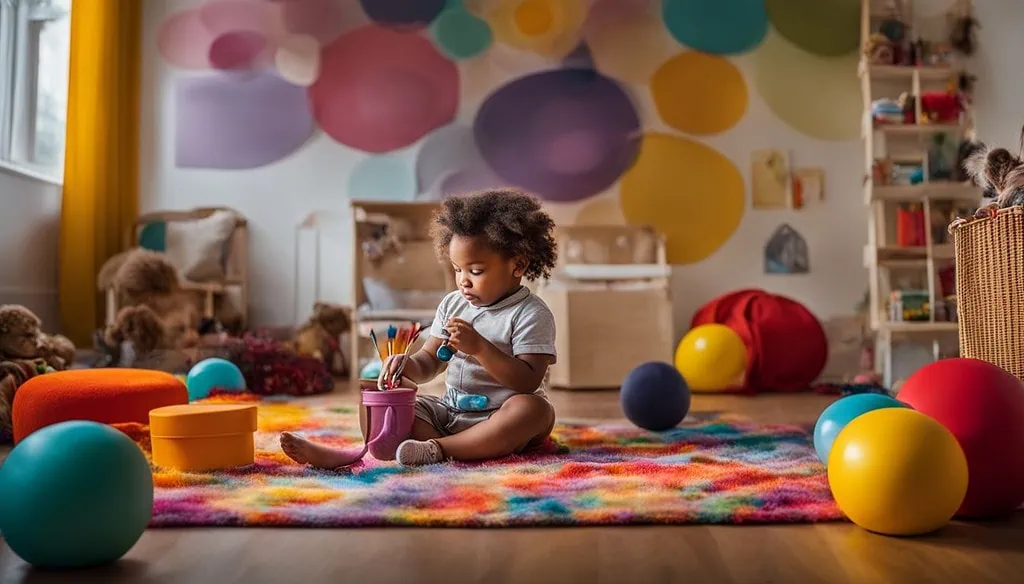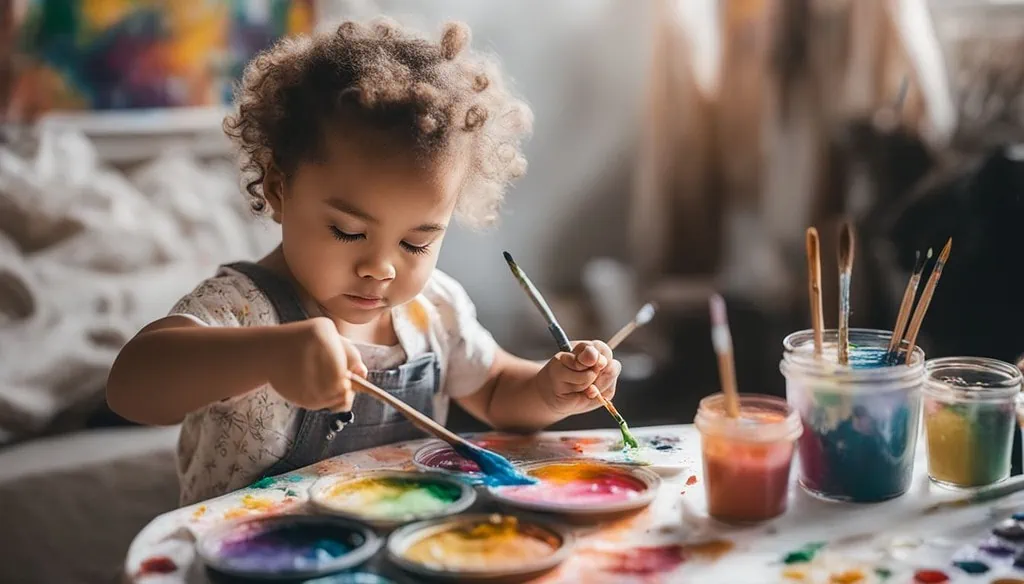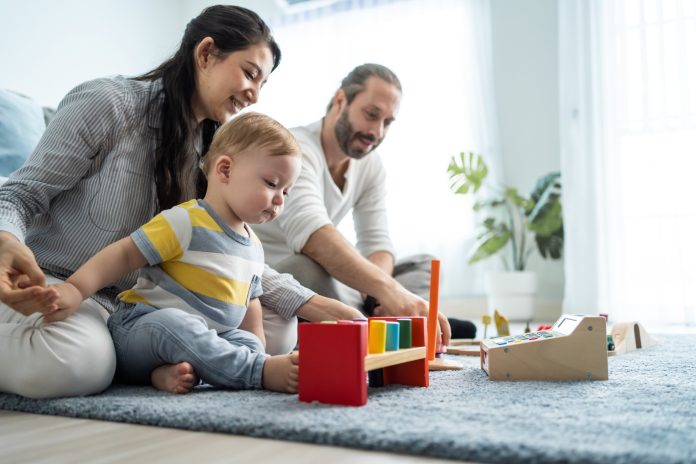Have you ever wondered when your pint-sized protege will start recognizing the rainbow in their crayon box? You’re not alone, and trust me, as my tyke toddled into their second year, I had that exact same query swirling around my mind! Research suggests that most little ones begin to identify primary colors around their 2nd birthday.
But remember, each child is beautifully unique, with individual milestones dancing on an extensive spectrum. This blog post aims to map out how and when toddlers embark on this color-filled learning adventure, sprinkling some handy tips for at-home color teaching techniques along the way.
Ready to weave through this vibrant tapestry articulated in hues of early childhood development? Let’s dive right in!
Highlights
- Toddlers usually begin to understand primary colors around their 2nd birthday.
- Activities like painting, color matching, and same-color games help toddlers learn about colors.
- Along with learning colors, toddlers start recognizing shapes, alphabets, and numbers, improving their sensory skills.
- Development issues such as color blindness can affect a child’s ability to recognize colors.
When Do Toddlers Learn Colors?

The age at which toddlers learn colors can vary, typically between 18 months and 3 years. They begin with a basic understanding of primary colors around age two. However, distinguishing subtle shades may pose challenges for them.
Developmental issues such as color blindness can also impact their color recognition skills.
A timeline of color
Seeing your child grow and develop essential skills, such as color recognition, is exciting as a parent. Here’s a timeline of color understanding for toddlers:
- At around 18 months old, toddlers typically start to recognize some colors.
- By the time most children reach the age of 2 years old, they begin identifying primary colors.
- However, for toddlers to fully master and verbalize all colors, it could take up until they’re 4 years old.
- Naming shapes is another critical development milestone that often comes slightly later than color recognition.
Developmental issues in learning colors
Babies begin to perceive colors and shapes as their visual-processing development starts. This is a critical milestone in their educational growth. However, developmental issues may arise when toddlers learn colors.
Most children initially struggle with differentiating various color shades which is completely normal during this development phase. Some might repeatedly confuse particular colors like red and green or blue and purple, an issue known as color confusion that can be addressed through targeted learning activities.
Additionally, children with conditions affecting visual perception could face specific challenges during the color recognition process.
Common challenges in color recognition
Teaching your toddler the intricacies of color can pose challenges. For instance, some may struggle to differentiate between colors like blue and purple. Understanding different shades might also be a hurdle for them, making it hard to recognize that light and dark green are both green.
Another common issue is generalizing this knowledge to other objects – they may know an apple is red but fail to connect that color with a red block. Experiences in learning colors can vary significantly from one individual to another due to unique developmental paths.
As parents, we have the vital job of creating supportive and engaging environments that facilitate our children’s journey toward understanding colors.
Tips for Teaching Toddlers Colors

Engage your toddler in simple activities like painting to help them understand colors. Use games involving colorful objects of the same hue for easy color recognition. Make coloring activities a regular playtime to enhance their color learning process.
Engage in simple activities like painting and color-matching
Engaging toddlers in stimulating activities like painting and color matching proves fruitful in teaching them colors. Here are some effective strategies and dynamic exercises you can partake in with your child:
- Delight in a finger-painting session: Coat their hands with different paint shades and watch as they leave colorful fingerprints on a canvas or paper. This promotes both color recognition and fine motor skills.
- Explore color sorting games: Use objects around the house, like colored toys, blocks, or clothespins. Ask your toddler to sort these items by color.
- Venture into nature with a “color hunt”: Encourage your toddler to find flowers or leaves in specific colors during a park visit.
- Make snack time a learning opportunity: Place fruits of various colors on their plate and ask them to identify each one’s color before eating.
- Introduce educational toys that incorporate colors: Puzzles, building blocks, or board games that use multiple colors for easy identification.
- Use art activities to enhance visual perception: From coloring books to DIY craft projects, integrating arts can significantly develop their cognitive skills while learning about different colors.
Play same-color games with colorful objects
Teaching colors to toddlers can be an exciting journey, full of fun experiments and joyful discoveries. Here’s how playing same-color games with colorful objects can bring incredible progress in color recognition among the little ones.
- Start by introducing one color at a time: Use objects around the house or in nature that are all the same color – such as red apples, cars, or flowers – during playtime. This cultivates their cognitive skills and piques their curiosity-driven learning.
- Move to multiple colors: Once your toddler recognizes one color, introduce another. You might bring blue into the mix, for example, using blueberries and blue toy blocks.
- Build up their vocabulary: As you play these games, use descriptive words related to the colors you’re teaching. This aids immensely in vocabulary building for the toddler.
- Encourage sorting activities: Let your child separate different colored objects into groups of their own colors. This will not only enhance color recognition but also develop sorting abilities.
- Incorporate shape recognition: To make learning more engaging and comprehensive, combine shapes with colors during playtime. For instance, ask your toddler to pass you a “green circle” or a “red square.”
Incorporate coloring activities

Incorporating coloring activities aids in teaching toddlers about different colors. Here are some ways I suggest you use this tip:
- Make use of coloring books that feature a variety of objects and themes to maintain their interest.
- Use crayons, colored pencils, or washable markers for these activities to give them hands-on experience with colors.
- Guide your toddler to fill in the images with color, helping them recognize each color by name.
- Create DIY coloring pages at home with familiar objects or shapes and ask them to color it using specific colors.
- Broaden their understanding of shades by introducing lighter and darker hues of the same color.
- Allow them to experiment with mixing colors; this encourages creativity and learning about secondary colors.
Other Skills Toddlers Learn Alongside Colors
As toddlers master their colors, they also begin learning about shapes, recognizing alphabets and numbers, reciting nursery rhymes, and refining sensory skills. Discover the exciting journey of toddler development in our full blog post!
Learning shapes
Learning shapes sparks a significant leap in your child’s cognitive development. Around age two, most children begin to name simple forms such as circles or squares. Fostering this ability enhances their spatial awareness, visual perception, and fine motor skills.
Toddlers also hone their problem-solving abilities as they start to recognize symmetry and patterns within different figures. Matching and sorting can expedite this growth by creating an engaging learning environment! By three years old, shapes usually solidify in their mind – even if it takes a few extra months compared to colors – shaping little geniuses one block at a time!
Alphabet recognition
As your toddler grows, they will begin identifying different colors, and alphabet recognition becomes a part of their learning journey. This early childhood education skill paves the way for more advanced language development and cognitive abilities.
Interacting with educational toys or engaging in activities that promote fine motor skills can enhance this process.
Visual recognition plays a crucial role when it comes to alphabet recognition. By incorporating multisensory learning methods into your preschooler’s routine, you encourage not only their understanding of the alphabet but also stimulate sensory skills.
From tracing letters in the sand to linking sounds with symbols, parental involvement at this stage can be instrumental in building solid foundations for reading and writing down the line.
Number recognition
Learning milestones in early childhood education extend far beyond colors, incorporating vital cognitive skills like number recognition. Your toddler’s numeracy journey usually starts between 2 and 4 years old, when they can begin identifying numerical symbols actively.
This ability allows them to understand that numbers represent quantities—a crucial step towards problem-solving skills later on. It’s not just about math; recognizing numbers is essential in numerous everyday tasks.
If toddlers struggle to identify numbers, they might also find those tasks challenging. Making the learning environment conducive to counting and symbol recognition can profoundly impact your little one’s cognitive development.
Nursery rhymes
Toddlers soak up nursery rhymes as effortlessly as they master other vital skills. This is because these catchy songs are not simply mere entertainment; they’re tools for enhancing early literacy, speech development, and vocabulary building.
Our young ones pick up new words, phonological awareness, and cognitive development cues from the rhythmical lines. They also learn communication skills through the repetition of lyrics.
Parents can make learning nursery rhymes more engaging by incorporating finger or body movements associated with each song. By doing this regularly, we provide our toddlers with a much-needed break from screen time while simultaneously promoting their language development in a fun and interactive way.
Sensory skills
Sensory skills are vital to my toddler’s overall learning and developmental journey. My little one employs her senses to experience the world around her, from visual discrimination, which is crucial for color recognition, to tactile experiences that enrich her sensory perception.
Sensory development doesn’t just boost academic achievement but also cultivates language and cognitive abilities. Notably, when my child learns colors using various textures and materials, she strengthens her visual skills, thus improving her ability to distinguish between similar-looking objects.
Ultimately, this helps build a strong foundation for future complex tasks such as reading and writing. This makes me appreciate how much toddlers can learn alongside mastering their colors!
Conclusion
Indeed, the journey of color recognition is fascinating in toddlers. While most start around two years old, it’s not a race – each toddler reaches this milestone at their own pace.
Engaging them through fun activities can make learning colors enjoyable and fruitful. It forms an essential step towards developing cognitive abilities in a child’s early life.
FAQs
1. At what age do toddlers usually start learning colors?
Toddlers typically start to learn and identify basic colors around 18 months to 2 years of age.
2. How can I teach my toddler about different colors?
You can introduce your toddler to different colors through fun activities like sorting colorful toys, painting, or using color flashcards.
3. Is it normal if my two-year-old doesn’t know his colors yet?
Yes, every child learns at their own pace and it is completely fine if a two-year-old does not know all the colors yet.
4. What are some signs that my toddler is recognizing colors?
If your toddler starts naming or pointing out the different hues in things they see daily like toys, clothes, food etc., that indicates they begin recognizing the colors.
5. Can color blindness affect a toddler’s ability to learn colors?
Yes, color blindness could make it more challenging for a toddler to distinguish between certain shades but there are special teaching methods available for such cases.
